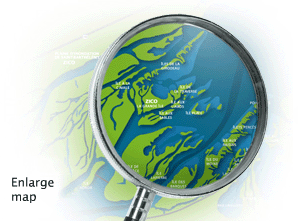|

From the end of March to the end of May, Canada Geese and Snow Geese stop over in the flood plains of Lake Saint-Pierre in order to feed themselves and rest. They eat scirpus rhizomes, leftovers from corn crops, and young shoots.
-------------------------------------------------------------------------------------------------------------------------
Having started their journey from the American coast, the geese stop here in order to replenish their energy supply before continuing their trip towards their nesting areas in the islands of the Far North.
-------------------------------------------------------------------------------------------------------------------------
The arrow-shaped flocks of Canada and Snow Geese line the sky as far as the eye can see.
-------------------------------------------------------------------------------------------------------------------------
At Baie-du-Febvre, the largest geese gatherings can be observed. These groups contain hundreds of thousands of geese.

-------------------------------------------------------------------------------------------------------------------------
In springtime, large numbers of anatidae (ducks) flock to the marshes. The Lake Saint-Pierre archipelago provides many suitable locations for nesting and raising their ducklings.
-------------------------------------------------------------------------------------------------------------------------
In this region, it is possible to find 72 % of all the bird species found in Quebec. Approximately 168 species breed in the archipelago of Lake Saint-Pierre.

-------------------------------------------------------------------------------------------------------------------------
The best site to watch rare species of birds in Eastern Canada is located at Île du Moine.
------------------------------------------------------------------------------------------------------------------------
Though Common Terns are widespread, they provide a superb aerial show, flying about and diving to capture small fish that make up their diet.
-------------------------------------------------------------------------------------------------------------------------
Killdeer can often be seen along the riverbanks. They can easily be recognized by their odd walk and strident, plaintive cry which inspired their name.
-------------------------------------------------------------------------------------------------------------------------
The marshes and swamps of Lavallière Bay are visited by a very diverse avian fauna. Rare species of birds are observed there on a regular basis.
-------------------------------------------------------------------------------------------------------------------------
In the last 10 years or so, the number of Double-crested Cormorants has increased greatly in Lake Saint-Pierre. As these birds eat large quantities of fish, sport and commercial fishermen fear that this increase in bird population will exert too much pressure on the Yellow perch stocks.
-------------------------------------------------------------------------------------------------------------------------
Measures are being undertaken in order to stabilize the breeding population of cormorants.
-------------------------------------------------------------------------------------------------------------------------

Birds of prey are often seen flying over the islands. They rise high in the sky, performing spirals and loops, hoisted by warm air currents. Thus this young Bald Eagle’s broad wings make it possible for it to glide, almost effortlessly, for a very long time, while searching the ground for its food.
-------------------------------------------------------------------------------------------------------------------------
Other birds of prey, such as the Turkey Vulture, use the same flight method, though usually in group formation, with their wings in the typical “V” shape. A pair of Peregrine Falcon, a species classified as threatened, builds its nest atop the grain silos located in the Sorel-Tracy port.
-------------------------------------------------------------------------------------------------------------------------
One can’t remain indifferent to the magnificent sight of a Common Loon gliding on the water, then, at the least disturbance, diving completely under the surface of the water, only to emerge at a considerable distance away.
Links |